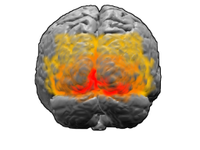
Photo from wikipedia
Ultra-high field MRI can functionally image the cerebral cortex of human subjects at the submillimeter scale of cortical columns and laminae. Here, we investigate both in concert, by imaging ocular… Click to show full abstract
Ultra-high field MRI can functionally image the cerebral cortex of human subjects at the submillimeter scale of cortical columns and laminae. Here, we investigate both in concert, by imaging ocular dominance columns (ODCs) in primary visual cortex (V1) across different cortical depths. We ensured that putative ODC patterns in V1 (a) are stable across runs, sessions, and scanners located in different continents, (b) have a width (∼1.3 mm) expected from post-mortem and animal work and (c) are absent at the retinotopic location of the blind spot. We then dissociated the effects of bottom-up thalamo-cortical input and attentional feedback processes on activity in V1 across cortical depth. Importantly, the separation of bottom-up information flows into ODCs allowed us to validly compare attentional conditions while keeping the stimulus identical throughout the experiment. We find that, when correcting for draining vein effects and using both model-based and model-free approaches, the effect of monocular stimulation is largest at deep and middle cortical depths. Conversely, spatial attention influences BOLD activity exclusively near the pial surface. Our findings show that simultaneous interrogation of columnar and laminar dimensions of the cortical fold can dissociate thalamocortical inputs from top-down processing, and allow the investigation of their interactions without any stimulus manipulation.
Journal Title: NeuroImage
Year Published: 2021
Link to full text (if available)
Share on Social Media: Sign Up to like & get
recommendations!